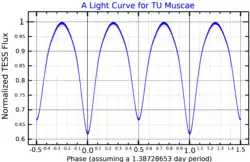| Observation data Epoch J2000.0 Equinox J2000.0 | |
|---|---|
| Constellation | Musca |
| Right ascension | 11h 31m 10.92470s[2] |
| Declination | −65° 44′ 32.1019″[2] |
| Apparent magnitude (V) | 8.307[3](8.17 - 8.75[4]) |
| Characteristics | |
| Spectral type | O7V + O8V[5] |
| U−B color index | −0.860[3] |
| B−V color index | +0.047[3] |
| Variable type | β Lyr[4] |
| Astrometry | |
| Radial velocity (Rv) | −4[6] km/s |
| Proper motion (μ) | RA: −6.62[2] mas/yr Dec.: −1.21[2] mas/yr |
| Parallax (π) | 0.02 ± 0.76 mas[2] |
| Orbit[5] | |
| Period (P) | 1.387 days |
| Semi-major axis (a) | 17.34 R☉[7] |
| Eccentricity (e) | 0 |
| Inclination (i) | 77.7° |
| Longitude of the node (Ω) | 3.137[6]° |
| Semi-amplitude (K1) (primary) | 214.5 km/s |
| Semi-amplitude (K2) (secondary) | 345.8 km/s |
| Details[5] | |
| Primary | |
| Mass | 16.8 M☉ |
| Radius | 7.2 R☉ |
| Luminosity | 105,000 L☉ |
| Surface gravity (log g) | 4.05[7] cgs |
| Temperature | 35,000[6] K |
| secondary | |
| Mass | 10.5 M☉ |
| Radius | 5.7 R☉ |
| Luminosity | 35,000 L☉ |
| Surface gravity (log g) | 4.04[7] cgs |
| Temperature | 31,366[6] K |
| Other designations | |
| Database references | |
| SIMBAD | data |
TU Muscae, also known as HD100213, is an eclipsing binary star in the constellation Musca. Its apparent magnitude ranges from 8.17 to 8.75 over around 1.4 days.[4]
Physical description
TU Muscae is a remote binary star system made up of two hot luminous blue main sequence stars of spectral types O7.5V and O9.5V, with masses 23 and 15 times that of the Sun. The stars are so close that they are in contact with each other (overcontact binary) and are classed as a Beta Lyrae variable as their light varies from earth as they eclipse each other.[6] The spectra indicate they are hot stars, with surface temperatures of roughly 37200 and 34700 K respectively. They are both still on the main sequence of star evolution, burning their core hydrogen. Astronomers Laura Penny and Cynthia Ouszt proposed the two were originally more equal in size but as they became close enough so that material from the less massive star began transferring to the more massive star via Roche-lobe overflow. However they concede that figuring out the evolution of interacting massive binary systems is "a little like trying to unspill milk".[5] The system is thought to be around 4.8 kiloparsecs (~15500 light-years) distant.[6]
The period of the magnitude change is increasing, and has been calculated as lengthening by 3.46 seconds a century. This could be due to material from the less massive star being transferred to the more massive one, or there could be a third or fourth as yet undetected star in the multiple star system influencing the orbit. These stars have not been seen as they are much less luminous than the two main stars.[8]
Discovery
TU Muscae was discovered by Dutch astronomer Pieter Oosterhoff in 1928. Initially thought to have a spectrum of B3, later observations in the 1960s and early 1970s indicated it was a hotter star than previously thought—with the spectrum lying in the uncommon O-region.[9]
References
- ↑ "MAST: Barbara A. Mikulski Archive for Space Telescopes". Space Telescope Science Institute. Retrieved 8 December 2021.
- 1 2 3 4 5 Van Leeuwen, F. (2007). "Validation of the new Hipparcos reduction". Astronomy and Astrophysics. 474 (2): 653–664. arXiv:0708.1752. Bibcode:2007A&A...474..653V. doi:10.1051/0004-6361:20078357. S2CID 18759600.
- 1 2 3 Maíz-Apellániz, Jesús; Walborn, Nolan R.; Galué, Héctor Á.; Wei, Lisa H. (2004). "A Galactic O Star Catalog". The Astrophysical Journal Supplement Series. 151 (1): 103–148. arXiv:astro-ph/0311196. Bibcode:2004ApJS..151..103M. doi:10.1086/381380. S2CID 118813863.
- 1 2 3 Samus, N. N.; Durlevich, O. V.; et al. (2009). "VizieR Online Data Catalog: General Catalogue of Variable Stars (Samus+ 2007-2013)". VizieR On-line Data Catalog: B/GCVS. Originally Published in: 2009yCat....102025S. 1. Bibcode:2009yCat....102025S.
- 1 2 3 4 Penny, Laura R.; Ouzts, Cynthia (2009). "Tomographic Separation of Composite Spectra. XI. The Physical Properties of the Massive Close Binary HD 100213 (TU Muscae)". The Astrophysical Journal. 681 (1): 554–61. arXiv:0905.3687. Bibcode:2008ApJ...681..554P. doi:10.1086/587509. S2CID 16333964.
- 1 2 3 4 5 6 Terrell, Dirk; Munari, Ulisse; Zwitter , Tomaˇz; Nelson, Robert H. (2003). "Observational Studies of Early-type Overcontact Binaries: TU Muscae". The Astronomical Journal. 126 (6): 2988–96. arXiv:astro-ph/0309366. Bibcode:2003AJ....126.2988T. doi:10.1086/379678. S2CID 6445980.
- 1 2 3 Palate, M.; Rauw, G. (2012). "Spectral modelling of circular massive binary systems. Towards an understanding of the Struve-Sahade effect?". Astronomy & Astrophysics. 537: A119. arXiv:1109.1103. Bibcode:2012A&A...537A.119P. doi:10.1051/0004-6361/201117520. S2CID 84840295.
- ↑ Qian, S.-B.; Yuan, J.-Z.; Liu, L.; He, J.-J.; Fernández Lajús, E.; et al. (2007). "Evolutionary states of the two shortest period O-type overcontact binaries V382 Cyg and TU Mus". Monthly Notices of the Royal Astronomical Society. 380 (4): 1599–1607. Bibcode:2007MNRAS.380.1599Q. doi:10.1111/j.1365-2966.2007.12184.x. hdl:11336/41984. S2CID 121158760.
- ↑ Andersen, J.; Grønbech, B. (1975). "The close 0-type eclipsing binary TU Muscae". Astronomy & Astrophysics. 45: 107–15. Bibcode:1975A&A....45..107A.
